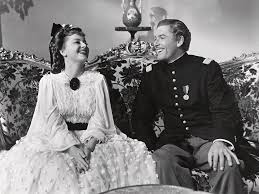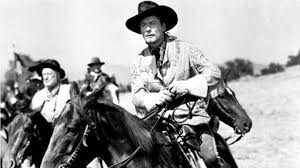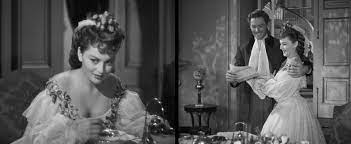🎬 They Died with Their Boots On (1941)

They Died with Their Boots On (1941) Review: A Romanticized Tale of Heroism and Tragedy
Directed by Raoul Walsh, They Died with Their Boots On is a sweeping historical drama chronicling the life and death of General George Armstrong Custer, portrayed by the charismatic Errol Flynn. Paired with Olivia de Havilland in their final collaboration, the film blends fact and fiction to create a grand, romanticized narrative of ambition, heroism, and the tragic cost of leadership. With its powerful performances, dynamic direction, and stirring score, the film remains a classic of Hollywood’s Golden Age.
Plot Overview: From West Point to Little Bighorn
The film traces Custer’s life from his cadet days at West Point through his military career during the Civil War and his fateful leadership at the Battle of Little Bighorn.
- George Armstrong Custer (Errol Flynn): A brash and ambitious cadet who rises to prominence through his daring leadership during the Civil War.
- Elizabeth “Libbie” Bacon (Olivia de Havilland): Custer’s devoted wife, who serves as his emotional anchor and confidante.
The story follows Custer’s ascent as a national hero and his controversial tenure in the West, where he clashes with corrupt officials and struggles to balance his loyalty to the U.S. Army with his growing empathy for the plight of Native Americans. The film culminates in the infamous Last Stand at Little Bighorn, portraying Custer as a tragic hero who dies fighting for his ideals.
Errol Flynn as George Armstrong Custer: A Dashing and Tragic Hero
Errol Flynn delivers a magnetic performance as Custer, capturing the general’s flamboyance, charm, and unyielding confidence. Flynn’s portrayal emphasizes Custer’s larger-than-life persona, portraying him as a fearless leader and devoted husband. While the film glosses over some of Custer’s historical controversies, Flynn’s charismatic performance elevates the character, making him both heroic and sympathetic.
Olivia de Havilland as Libbie Bacon: The Heart of the Story
Olivia de Havilland brings warmth and grace to the role of Libbie Bacon, Custer’s loyal and loving wife. Her chemistry with Flynn is undeniable, and their romantic scenes add emotional depth to the film. Libbie’s unwavering support for her husband serves as a counterpoint to the challenges and tragedies he faces, grounding the story in a heartfelt love story.
Supporting Cast: Adding Drama and Conflict
- Arthur Kennedy as Ned Sharp: Kennedy portrays a corrupt businessman whose exploitation of Native lands creates conflict with Custer, adding tension to the narrative.
- Gene Lockhart as Samuel Bacon: As Libbie’s skeptical father, Lockhart provides a touch of humor and drama, reflecting the challenges of their unconventional marriage.
- Anthony Quinn as Crazy Horse: Quinn’s portrayal of the legendary Sioux leader is brief but impactful, lending gravitas to the climactic battle scenes.
Themes: Heroism, Tragedy, and the Cost of Ambition
- The Complexity of Leadership: The film explores Custer’s dual role as a bold leader and a flawed human being, emphasizing the burdens of command.
- Romanticized Patriotism: Custer is depicted as a man driven by honor and duty, reflecting Hollywood’s tendency to glorify historical figures during the early 1940s.
- The Tragic Cost of War: The Battle of Little Bighorn is portrayed as a noble but doomed stand, underscoring the futility and human cost of conflict.
Direction and Cinematography: A Grand and Sweeping Vision
Raoul Walsh’s direction imbues the film with energy and grandeur, balancing intimate character moments with large-scale battle sequences. The cinematography by Bert Glennon captures the sweeping landscapes of the American West, creating a vivid backdrop for the narrative. The climactic scenes at Little Bighorn are particularly striking, with dynamic camera work and meticulous staging that heighten the tension and drama.
Historical Accuracy: Fact Meets Fiction
While They Died with Their Boots On draws inspiration from real events, it takes significant liberties with historical facts. The film romanticizes Custer’s character, portraying him as a noble hero rather than addressing the more controversial aspects of his legacy. Similarly, the depiction of Native Americans, while occasionally sympathetic, reflects the biases of its era and oversimplifies their role in the conflict.
Key Moments That Define They Died with Their Boots On
- Custer at West Point: The film opens with Custer’s rebellious and unconventional behavior as a cadet, establishing his larger-than-life personality.
- Custer and Libbie’s Romance: The tender scenes between Custer and Libbie provide an emotional foundation for the story, showcasing their deep love and mutual devotion.
- The Last Stand: The climactic battle at Little Bighorn is a dramatic and visually stunning sequence, portraying Custer’s final moments as both heroic and tragic.
Strengths of They Died with Their Boots On
- Errol Flynn and Olivia de Havilland’s Chemistry: Their eighth and final on-screen pairing is as captivating as ever, adding emotional depth to the story.
- Sweeping Production Values: The film’s grand scale, from its battle sequences to its detailed period costumes, immerses viewers in the historical setting.
- Dynamic Direction: Raoul Walsh’s ability to balance action, drama, and romance ensures the film remains engaging from start to finish.
- Stirring Score: Max Steiner’s musical score enhances the film’s emotional impact, particularly during its most dramatic moments.
Weaknesses of They Died with Their Boots On
- Historical Inaccuracies: The film’s romanticized portrayal of Custer and its oversimplification of historical events may frustrate viewers seeking a more accurate depiction.
- Simplistic Characterizations: The Native American characters, while treated with some sympathy, are largely one-dimensional.
- Pacing Issues: At 140 minutes, the film occasionally drags during its middle act, though the final battle delivers a thrilling payoff.

Legacy and Reception
They Died with Their Boots On was a critical and commercial success upon its release, cementing Errol Flynn’s status as one of Hollywood’s top stars and marking the end of his celebrated partnership with Olivia de Havilland. While modern audiences may critique its historical inaccuracies and dated perspectives, the film remains a beloved classic for its sweeping scope, compelling performances, and emotional resonance.
Fun Facts About They Died with Their Boots On
- Flynn and de Havilland’s Final Pairing: This was the eighth and last film featuring Flynn and de Havilland, one of Hollywood’s most iconic on-screen duos.
- Battle of Little Bighorn Recreation: The climactic battle sequence involved hundreds of extras and meticulous choreography to recreate the infamous Last Stand.
- Max Steiner’s Score: The renowned composer’s stirring music enhances the film’s grandeur and emotional depth, solidifying its place in cinematic history.
Conclusion: A Romanticized but Enduring Classic
They Died with Their Boots On (1941) is a quintessential example of Hollywood’s Golden Age, offering a sweeping and romanticized portrayal of one of America’s most controversial historical figures. While its historical liberties and dated perspectives may not appeal to modern sensibilities, its grand storytelling, stellar performances, and dramatic intensity ensure its lasting appeal. For fans of classic cinema and Errol Flynn, this film is an essential watch.